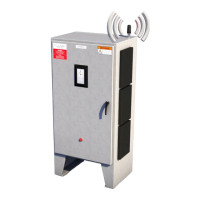17
Section 4: Genesis Controller Control
Options and Examples
The Genesis Controller system allows different options
for heat trace control.
• Line sensing (RTD Sensor on pipe-wall and requires
consideration of process flow.)
• Ambient Sensing (“On-off” or Ambient Proportional
Control)
The most energy efficient control mode is to use one
(or more) line sensing RTD’s for each heat trace circuit.
For winterization, ambient sensing is the most
common because it represents the fewest electrical
circuits and lowest installed cost. See Figure 2, below.)
It is also the least accurate method of control; all
connected heaters are energized when the ambient
temperature falls below the control set-point.
• Ambient “On-off” control delivers 100% power
whenever energized, the least energy efficient.
• Ambient Proportional Control (APC with Solid State
Relays, or APC-M with Mechanical Relays) delivers a
percentage of power determined by the difference
between the desired maintain temperature and
the measured ambient temperature at any time.
(More energy efficient than Ambient “On-Off”, but
not as efficient as line sensing.)
4.1: Line Sensing Control
When the RTD is directly sensing pipe-wall surface for
control, the key parameters are “Maintain Temperature”
at which the heat trace is energized or turned on. The
“Max” temp setting is where the heat trace will be
de-energized, or turned off. The difference between
these control settings defines the “Control band” (aka
“control differential” or dead-band)
The line sensing RTD(s) temperature is read by the
Genesis Controller for heater control for low and high
temperature alarms. (A “high-high” temperature
setting with circuit “trip” option is also determined
from the line sensing RTD(s).) When configured
with more than one RTD sensor, Genesis Controller
displays and controls from the lowest temperature
RTD reading, and alarms are triggered from the
highest.
4.2: Ambient Sensing Options
For the Genesis Controller system, (and its
predecessor the TCM18), “Ambient Proportional
Control” or APC, refers to a “time proportioning”
function for saving energy when compared to
Ambient Sensing “On-Off” temperature control. As an
example, if a given situation calls for 50% power, then
the controller cycles on and off 50% of the time to
achieve this energy delivery.
APC mode is less energy efficient than line-sensing
control, but generally allows fewer heating circuits
and longer circuit lengths.
Ambient Proportional Control can be successfully
used for maintaining elevated process temperatures
as well. This can reduce the number of heating circuits
by allowing longer heating circuits, but will not be
as energy efficient as line-sensing RTD temperature
control .
The APC method has traditionally utilized solid
state control relays capable of rapid cycling during
operation. By expanding the cycle time to 20 minutes
between “on” and “off”, however, mechanical relays
can be used. This is referred to as APC-M.
Heater Relay Type
Control relays for Genesis Controller can be either
solid state or mechanical switching relays. The Genesis
Controller control output is a nominal DC voltage of
24 Vdc to drive the solid state or mechanical relays.
There are advantages and limitations of both relay
types. Consult your Thermon service provider if you
have questions.
Control Band
Ambient Sensing Control without concern for ow path
Splices
Thermostat
Line Sensing Control considering possible ow paths
Power Connections
End Terminations
Thermostat
Power Connection

